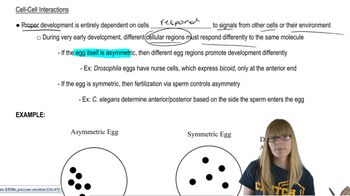Early development depends on the temporal and spatial interplay between maternally supplied material and mRNA and the onset of zygotic gene expression. Maternally encoded mRNAs must be produced, positioned, and degraded [Surdej and Jacobs-Lorena (1998). Mol. Cell Biol. 18:2892–2900]. For example, transcription of the bicoid gene that determines anterior–posterior polarity in Drosophila is maternal. The mRNA is synthesized in the ovary by nurse cells and then transported to the oocyte, where it localizes to the anterior ends of oocytes. After egg deposition, bicoid mRNA is translated and unstable bicoid protein forms a decreasing concentration gradient from the anterior end of the embryo. At the start of gastrulation, bicoid mRNA has been degraded. Consider two models to explain the degradation of bicoid mRNA: (1) degradation may result from signals within the mRNA (intrinsic model), or (2) degradation may result from the mRNA's position within the egg (extrinsic model). Experimentally, how could one distinguish between these two models?
Table of contents
- 1. Introduction to Genetics51m
- 2. Mendel's Laws of Inheritance3h 37m
- 3. Extensions to Mendelian Inheritance2h 41m
- 4. Genetic Mapping and Linkage2h 28m
- 5. Genetics of Bacteria and Viruses1h 21m
- 6. Chromosomal Variation1h 48m
- 7. DNA and Chromosome Structure56m
- 8. DNA Replication1h 10m
- 9. Mitosis and Meiosis1h 34m
- 10. Transcription1h 0m
- 11. Translation58m
- 12. Gene Regulation in Prokaryotes1h 19m
- 13. Gene Regulation in Eukaryotes44m
- 14. Genetic Control of Development44m
- 15. Genomes and Genomics1h 50m
- 16. Transposable Elements47m
- 17. Mutation, Repair, and Recombination1h 6m
- 18. Molecular Genetic Tools19m
- 19. Cancer Genetics29m
- 20. Quantitative Genetics1h 26m
- 21. Population Genetics50m
- 22. Evolutionary Genetics29m
14. Genetic Control of Development
Early Developmental Steps
Problem 25
Textbook Question
Dipterans (two-winged insects) are thought to have evolved from a four-winged ancestor that had wings on both T2 and T3 thoracic segments, as in extant butterflies and dragonflies. Describe an evolutionary scenario for the evolution of dipterans from four-winged ancestors. What types of mutations could lead to a butterfly developing with only two wings?
 Verified step by step guidance
Verified step by step guidance1
Understand the anatomical context: In insects, the thorax is divided into three segments—T1, T2, and T3. Wings typically develop on T2 and T3 in four-winged insects like butterflies and dragonflies, while dipterans have wings only on T2, with T3 bearing halteres (small balancing organs).
Consider the evolutionary changes: The transition from four wings to two wings likely involved changes in gene regulation that suppressed wing development on the T3 segment, transforming wings into halteres.
Identify key genetic players: Homeotic genes, especially those in the Hox gene complex such as Ultrabithorax (Ubx), control segment identity and appendage development. Mutations or changes in expression of these genes can alter the fate of T3 from wing to haltere.
Describe mutation types: Mutations could include regulatory mutations that change the expression pattern of Ubx, leading to repression of wing formation on T3, or coding mutations that alter the function of proteins involved in wing development pathways.
Summarize the evolutionary scenario: Natural selection could favor individuals with reduced wings on T3 if halteres provide better flight stability, leading over time to fixation of mutations that suppress T3 wing development and produce the dipteran two-winged body plan.
 Verified video answer for a similar problem:
Verified video answer for a similar problem:This video solution was recommended by our tutors as helpful for the problem above
Video duration:
3mPlay a video:
Was this helpful?
Key Concepts
Here are the essential concepts you must grasp in order to answer the question correctly.
Evolutionary Modification of Thoracic Segments
Insects have three thoracic segments (T1, T2, T3), each potentially bearing wings. Dipterans evolved by losing or transforming the wings on the third segment (T3), resulting in only two functional wings on T2. Understanding how segment identity changes during evolution helps explain morphological differences between species.
Recommended video:
Guided course

Post Translational Modifications
Homeotic (Hox) Gene Mutations
Homeotic genes control the identity of body segments during development. Mutations in these genes can cause one segment to develop features typical of another, such as wing loss or transformation. Changes in Hox gene expression can lead to the suppression or modification of wings on specific thoracic segments.
Recommended video:
Guided course

Plant HOX genes
Genetic and Developmental Mechanisms of Wing Formation
Wing development involves multiple genes regulating growth and patterning. Mutations affecting these genes can reduce or eliminate wing structures. For example, mutations in regulatory genes or signaling pathways can cause wings on T3 to be lost or transformed into halteres, as seen in dipterans.
Recommended video:
Guided course

Cell-cell interactions

 3:46m
3:46mWatch next
Master Drosophilia Development with a bite sized video explanation from Kylia
Start learningRelated Videos
Related Practice
Textbook Question
905
views
